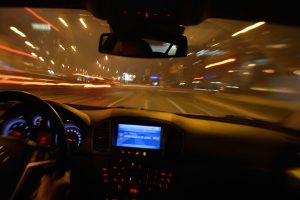Over 50% of traffic deaths occur between dusk and dawn. Fatigue, compromised night vision and congested driving conditions all contribute to a higher percentage of accidents during nighttime driving.
Daylight savings time starts the first Sunday of November. With fewer daylight hours, the rate of vehicle collision fatalities is three times higher when driving in the dark. Three major causes of deaths can be attributed to the body: fatigue, darkness, and compromised night vision.
- Fatigue – Over 4 million individuals say that falling asleep has caused a vehicular accident. Many reasons for fatigue exists, but can be attributed to lack of sleep, shift work, long working hours, or lengthy trips. These numbers could be lowered if individuals would take the time to have a restful sleep before driving, stopping every two hours while driving, or just merely pulling over and taking a nap to rest or get something to eat or drink.
- Darkness – Even with high-beam headlights, our depth perception, color recognition, and peripheral vision are compromised when we drive in the dark. The lack of normal depth in vision means that there is less time to react to something in the road. By aiming headlights correctly, diming onboard lights, looking away from oncoming lights, and keeping a clean dash/windshield, the view can be clearer and reaction time quicker.
- Compromised Night Vision – As we get older, there is a higher difficulty of seeing at night. With vision compromised, it is important to have annual vision exams, reduce driving speeds, minimize distractions, and try to drive primarily during daytime hours.
In addition to the physical challenges we face when driving at night, traffic congestion, road hazards or construction, and animals unexpectedly crossing the road can also contribute to the dangers of driving after dark.
Impaired drivers, individuals intoxicated or on drugs, are most frequently on the road after dark, between midnight and 3 AM. While drunk driving has decreased by one-third since 2007, there is a significant increase in drivers under the influence of drugs on the road. Impairments can also mean utilizing technology, which can result in serious injury for the driver themselves, fellow drivers, passengers, and pedestrians.
Next time you are behind the wheel at night, take note of how your body feels: pull over to rest or stop to get something to eat if you need to. By slowing down and being aware of your surroundings, and other drivers on the road, you can help to reduce driving accidents.
Source: National Safety Council
